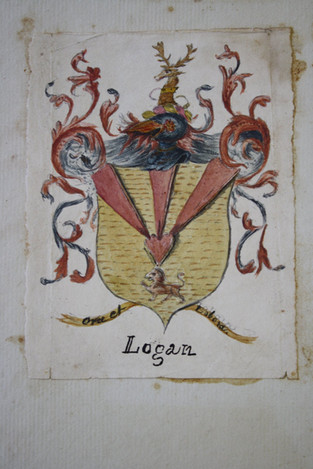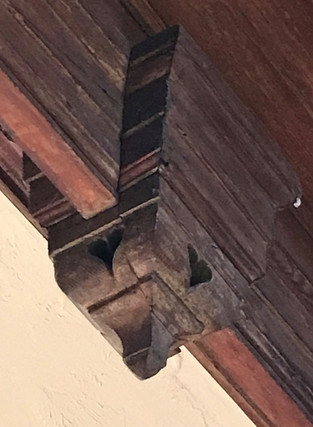Hearts: heraldry, decorative motif, or both?

The hearts carved into the pendant drops over Stenton's interior entry hall doors are distinctive and draw one's eye up, obscuring the asymmetry of the room, which accommodates a fireplace to one side and a cupboard to the other. What is the meaning of this common European decorative motif in the context of Stenton? The hearts may be gentle allusions to the Logan coat of arms featuring a heart pierced by nails. Arms commonly appeared over thresholds such as doors and gates. However, Stenton is not the only early Philadelphia house to display this feature, which is found on all four sides of a single pendant drop in the Bellaire stair hall in Passyunk. And hearts are also to be found on pendent drops in the skirts of some Philadelphia case furniture of the same period.
Image Captions: 1) Deborah Norris Logan’s own sketch of the Logan arms in her Family Record manuscript. Robert Restalrig Logan Papers, Pennsylvania State Archives, Harrisburg. Note the stag’s head crest. 2) The Stenton Entry seems symmetrical, with pairs of double doors in all four directions. The doors obscure the actual asymmetrical and practical allocation of functional space, which allows for heat and storage in the room.
3) Hearts carved into a four-sided pendant drop in the stair hall of Samuel Preston’s c.1715 single-pile gentleman’s house, Bellaire, in Passyunk (South Philadelphia). Preston’s wife, Rachel Lloyd, and Mary Lloyd Norris, wife of Isaac Norris, were sisters. According to James Logan’s 1720s Ledger, he paid duty on the importation of enslaved people to Preston. 4) Maple high chest of drawers, Philadelphia or Trenton, c.1735-1745, attributed to Henry Carter, Philadelphia Museum of Art. Note the heart piercing the pendant drop in the skirt.




























Comments